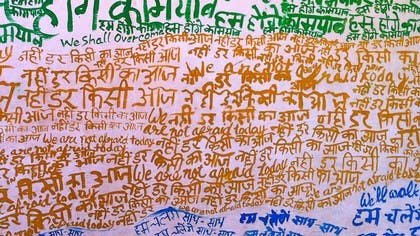Description
About This Video
Transcript
Read Full Transcript
Namaste. The beautiful, mystical temples of India. How do you visit them? In the West, houses of worship are open, but in the East, there are often entries that are blocked by police and there are many steps. How do you get into a temple and how do you show respect as someone who is a visitor and a visitor for the first time? The main thing to remember about visiting temples in India as well as mosques and stupas is that cleanliness is a huge part of just everyday culture. So before you visit a temple, make sure that you take a bath, that you wear clean clothes, wear something that you feel good in, and that you are covered. One of the basics of temple etiquette is to make sure that your arms and shoulders are covered and that you're not wearing short pants if you're a man. You should always be wearing full pants. But cleanliness is really, really key. What are all those sandals sitting outside of the temple? And who's that man with the stick watching the sandals? He is the chapelminder and you will be asked to leave your sandals at the door when you go into the temple. Leaving your shoes is a big part of Indian culture, but especially in temples where taking steps in with your shoes that have touched the streets is considered a taboo. So when you take your shoes off at the man who is the chapelminder, it's really important to take your shoes off in such a way that you don't touch the soles of your feet. Because touching the feet that have been exposed to the streets and then touching God, who would do that? As Westerners, we don't have a lot of experience with this kind of precision of worship. So as you step into the Indian temple, it's important to remember that your footsteps and your fingerprints, that they are all moving towards God and you should do it in your best shape. As a woman, it's really important to bring a scarf with you when you visit temples so that you can cover your chest or wrap it over your head to show respect. The religions in India are so vast. So you may experience Hindu temples devoted to a myriad of gods and goddesses, or Buddhist holy sites, or Islamic, what are called masjid or musks. The musks in India are an incredible experience. And what you'll notice that's very interesting is the offerings at all of these places are very similar. These offerings are called prasad or prasad, and they're usually flowers, sweets, garlands of roses or garlands of flowers, sometimes maybe even objects, but most commonly flowers. As you approach the temple, you'll always see tons of stalls set up to sell you things to bring into the temple. And this idea is really because people believe that once you've entered that place and you've made an offering, you leave there with the blessing of the gods. The prasad in its food form, which is usually sweet, is blessed by whatever God and given back to you so that as you leave the temple and share this offering with your friends or share it with people you just meet outside of the temple, you're giving them sacred food to assimilate the blessing into their body. As Westerners, we're less familiar with the idea that blessings cost money. But in India, because the tradition is ancient, and it is a lineage, the minders of the temples have to be paid for the blessings. So in most places, as you enter and you make an offering, the offering is usually made with a small amount of money. If you give 10 rupees or 20 rupees in most temples, that's a generous offering, or maybe you're hoping to have a lot of good luck. And so you'll offer a coconut and say 101 rupees. Try not to get too attached to this amount of money and just let it go. Because when you enter the temple, this is really not what's important. The important part is your devotion, the energy with which you show up and the blessing that you receive from the gods. The last piece of temple etiquette that is very key is to know that not all temples will allow you to take photos. You've probably seen photos in magazines all over the world or all over the internet that show the beautiful rituals that happen in India and the various temples. And in some places, this is appropriate, but in many places in India, they will ask you not to take photos and there will be signs that say you can't bring your camera inside. My suggestion from my experience is to approach this in a very casual way and to maybe try your first few temple visits without a camera and to just see how it feels to take the picture with your eyes and to just feel the blessings in your heart and to absorb the sights that you see in this ecstatic type of worship in a new way.






You need to be a subscriber to post a comment.
Please Log In or Create an Account to start your free trial.